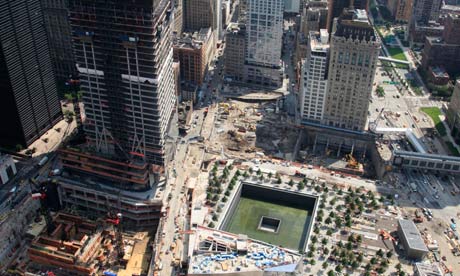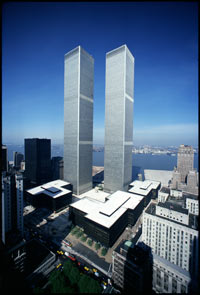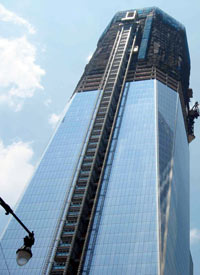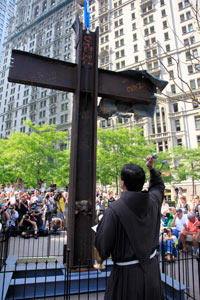http://www.guardian.co.uk/world/2011...l-architecture
9/11 Ground Zero: why has its rebirth turned sour?
Ten years on from the 9/11 attacks, the project to rebuild New York's World Trade Centre site is still riven by political and professional infighting
Rowan Moore
The Observer, Sunday 31 July 2011
Article history

Work under way at the World Trade Centre site in New York, July 2011. The square fountains that sit where the Twin Towers once stood open to the public on the 9/11 terrorist attacks' 10th anniversary. Photograph: Mark Lennihan/AP
This 11 September, exactly 10 years after the Twin Towers of the World Trade Centre fell, politicians and relatives of the victims will gather in a grove of 415 trees planted on the event's charged ground. Two huge cascades of water, each occupying the square footprint of one of towers, will start churning, ceaselessly, forever. Inscribed in a bronze strip surrounding the cascades will be the names of those killed in the 9/11 attacks, including those at the Pentagon and on United flight 93, which crashed in a field in Pennsylvania, as this is the national 9/11 memorial, not just New York's.
The memorial will be ready, just, although it will be accessible only by advance booking for another two years. It could not miss this deadline. Despite billions of public dollars, thousands of ideas for memorials and rebuilding, a shared public desire to honour the event and speeches by governors and mayors about the urgent need to get things done, perhaps a third of all the reconstruction that will happen here has so far taken place.
Work on 7 World Trade Centre, a relatively plain tower at the edge of the site, was completed in 2006. Otherwise, the grove and the fountains stand among pits, canyons, cranes and rising frames, a Bosch landscape of machines and mud, of digging down and piling up, as skyscrapers, a train station, a museum and 550,000 sq ft of retail space take shape.
"It is very New York," is what everyone connected with the project says, by which they mean that everyone has an opinion and an interest, which must face down the opinions and interests of others. Much of the past decade has been spent in arguing, in law courts, in the media, at public and private meetings. Relatives of victims had different views from one another, and from people living near the Ground Zero site, who did not want their neighbourhood to become a shrine to catastrophe. One of the residents' leaders was told she would "burn in hell". Construction became political: protestors against slow progress carried placards saying: "Don't forget 9/11. Delay means defeat." There was rage and defiance, a desire to stick it back to the terrorists, which made it very likely that large towers would be put back on the site.
In the years following 9/11, the event was honoured by a carnival of pretention and viciousness, as architects felt compelled – as there can be narcissism in healing – to put themselves at the centre of the stage cleared by the attacks. "We're going to crush his nuts," said one of another, while others preened and posed and drivelled about the fusion "of military and urban space" or new towers that would "kiss and touch and become one". They employed black propaganda, old boys' networks, emotional posturing and shameless spinning. At stake was the greatest commission in the world, the chance to shape 16 acres of Manhattan property that were also the site of the most momentous event of the 21st century thus far. It was not just about the memorial but about the towers, station and museum that would go on the site as well.

The way they were: the World Trade Centre’s twin towers dominate the New York skyline in the 1990s. Photograph: Peter J. Eckel/Time & Life Pictures/Getty
After a false start or two, several architects were asked to take part in an "innovative design study", a process that was not supposed to have any winners. Then a winner was chosen, a group called Think, a decision overturned the next day by George Pataki, the governor of New York State, who chose Daniel Libeskind instead.
Libeskind's design studies were then called a masterplan, even though there had not been the time or money to work them out as fully as a masterplan would normally be. They then acquired the status, at least for some politicians, of designs for individual buildings, which they were not either. What were essentially sketches were treated as blueprints for multibillion-dollar structures.
Libeskind is the Polish-born son of Holocaust survivors, and designer of the Jewish Museum in Berlin, who, as a teenager, had arrived in New York, in the time-honoured way of immigrants, by boat. He was well placed to speak of freedom, hope, conflict and tragedy. His proposals, in which fractured geometric forms rose into a triumphant spiral said to echo the Statue of Liberty's torch, soaked the site in symbols. Its pinnacle would be the tallest building in the world – 1,776ft high in honour of the date of the American Declaration of Independence – which Pataki would name the Freedom Tower.
Nor was Libeskind afraid, though no Republican, to borrow the Bushite warping of language that followed 9/11: "Freedom" to mean "America", "heroes" to mean "victims". He called his project "Memory Foundations" and said it represented "life victorious". Libeskind is intelligent – when he received news of his win he was reading God, Death, and Time by the talmudist Emmanuel Levinas – but he can sound remarkably simplistic when he wants to.
There was a snag. "That idiot," as one of his rivals puts it, uncharitably, "he forgot that most American of things – the contract." There were in fact other architects engaged to work on the site, the giant, business-friendly practice Skidmore, Owings & Merrill. SOM had been hired by Larry Silverstein, the developer who bought a long lease on the towers in the summer of 2001, a few weeks before they fell, and they were still his architects. His lease required him to put back all 10 million sq ft of the office space destroyed, so his views mattered. According to Janno Lieber of the Silverstein Corporation: "Larry said to Libeskind, 'Congratulations, this is a phenomenal plan. You've managed to accommodate everyone. But – no disrespect – I'd like my architects to design the individual buildings.'"
The main man at SOM was David Childs, now aged 70, prominent for decades in American architecture but never adulated like its more glamorous stars. His style is courteous but ruthless, that of one used to getting his own way. The project was also personal for him, as it was for many. A member of SOM's staff was killed in the attacks and Childs and his team had all too good a view from their Wall Street offices, a few blocks away. "There was a young man with tears streaming down his face," recalls Childs. "He said, 'Will they fall?' I said, 'No.'"
Pataki pushed Libeskind for a while but, according to Childs, Silverstein needed architects with experience of large buildings, such as SOM. Libeskind wanted to design the Freedom Tower, the most conspicuous element of his plan, but found himself put in a junior partnership with SOM ("We're a team organisation but we needed 51% of the vote," is how Childs describes it). Then he became an increasingly marginal figure as Childs redesigned the tower as he wanted it.
The outcome of the Childs/Libeskind showdown is now the most prominent object in the place that in the 1960s was named the World Trade Centre, became Ground Zero in 2001 and now – to lighten its load of significance – is called the World Trade Centre again. The rising tower, its slick skin chasing its steel-and-concrete frame up to the sky, is already taller than anything in Britain but still far from its final height. Libeskind wanted a dynamic, asymmetrical shape but the tower will now be a symmetrical obelisk, in emulation of the Washington Monument in Washington DC. Childs calls it "iconic and simple".
The Freedom Tower, now renamed 1 World Trade Centre, looks assertive and confident, like the towers of corporate America anywhere, but it has contradictions. It is unsure if it is a symbol or a piece of commercial real estate. Childs refers to the Washington Monument but also cites the importance of "market realities", among other things, as a reason for discarding Libeskind. Yet its size is grandiose and its security measures elaborate, for obvious reasons, which make it expensive in a location that is not New York's hottest commercial spot. It does not obviously respect market realities. At least, it did not convince Silverstein, who refused to build it, meaning that the Port Authority of New York and New Jersey, the public body that owns the freehold, decided to put its own funds into putting up the tower, with uncertain prospects of an early, sufficient return on its investment.

Freedom Tower nears completion. Photograph: Rowan Moore for the Observer
The tower is the pinnacle of Childs's career, as it would be of any architect's, yet he is openly contemptuous of what might seem an important design feature, its height. This, achieved with the help of a large steel stick, retains the magic number specified by Libeskind: "1,776 feet, whatever that's worth," says Childs. "Nobody's going to count the feet."
The rebuilding of Ground Zero is an immense public building project, consuming billions of public dollars, pushed by mayors and governors, of a scale that would impress an old-fashioned socialist despot. Yet it is also a commercial development by the Silverstein Corporation. Its most important guiding document is Silverstein's lease agreement of summer 2001 and its requirement, blind to the imminent attacks and the emotional charge they would bring, that any destroyed accommodation should be put back. It meant that, whatever else happened, there would be very large office blocks on the site.None of the powerful people involved with the site since then has been able or willing to change this requirement.
At the same time, it was impossible for anything built there not to be a symbol, given what had happened and given the geometric potency of the Twin Towers. Their architect, Minoru Yamasaki, dreamed, with hopelessly misplaced optimism, that they would become "a representation of man's belief in humanity, his need for individual dignity, his beliefs in the co-operation of men, and through co-operation, his ability to find greatness". The fearful symmetries of their downfall, and the contrast between the perfection of their forms and the chaos of their collapse, ensured that architecture and construction were enmeshed in the event.
Hence the contradictions. Is it a symbol? Is it an office block? It is both.
What are most clearly symbols are the two square cascades of the memorial, which lie in front of the tower in an eight-acre plaza containing the grove of 415 trees. The memorial is by Michael Arad, the architect who won a design competition held in 2003-4, beating 5,200 entrants. He was 34 at the time, unknown and inexperienced, and has realised the work in partnership with the well-established landscape architect Peter Walker.
Arad was living in Lower Manhattan at the time of the attacks and, like many, "was very affected by what I saw and felt compelled to do something about it". He recalls the place as a "ghost town" after 9/11, but with people instinctively gathering at night in public places such as Washington Square. From this, he learned that "public spaces are the glue that binds society together".
Almost immediately, Arad started imagining a memorial, spending "a lot of time and effort drawing and sketching and modelling". He came up with two squares set in the Hudson River, "with the surface of water torn open, by voids that will never fill". Then the competition was announced and he adapted his idea to the location at Ground Zero. At the same time, inspired by his discovery of the power of public space, he wanted them set in a large, flat, open plaza. He called his plan "Reflecting Absence" and won.
For Walker, the main problem was maintaining the flatness and openness of the plaza, which was essential to Arad's design, without making it bare and arid. The most important part of the answer is the trees, selected and nurtured, with great difficulty, so that they are all the same size.
Both Walker and Arad had to fight the many pressures to put unwanted stuff in the empty space, such as skylights for the train station or 17 air vents 20ft high. "How can you make something flat with 17 vents in it?" says Walker, who needed Pataki's help to sort out that one. They had to find the right kind of seating: park benches seemed inappropriate but so did oblong slabs that "looked as if they might have a dead person underneath"; so the slabs had to be given dimensions that made them look less tomb-like.
They had to make the cascades work, with the help of a mock-up in Toronto, and Walker still sounds a caution. "We've made them as well as we know how, but they're mechanical and usually mechanical things only last 30-40 years." Somehow, the money will have to be found to pump the water round for ever and ever. You get the impression Walker would not have gone for fountains if it had been up to him.
Arad wanted the names of the victims to be inscribed near the bottom of the cascades, with visitors descending to them behind the screen of falling water. Cost and security issues made this prohibitive and the names will now be around the cascades' upper rim, at the level of the plaza.
Even this simpler presentation took years to resolve, not least because of the question of the order in which the names, which include the six people who died in the 1993 attack on the World Trade Centre, would be arranged. Should they be alphabetical? Should they be random? Eventually it was agreed that names should be arranged by groupings of place – who was in which tower, on the ground, in which plane or in the Pentagon. However, relatives were invited to make "meaningful adjacency requests", of which 1,200 were received, whereby they could ask for particular names to be together.
Arad's and Walker's other concern was, as it was for most who have touched this site since 2001, the balance of remembrance and renewal. "A lot of people," says Arad, "thought it had to be either a living park or a cemetery and a forever dismal place." The combination of the fountains and the canopy of trees is intended to house both death and life, both acts of pilgrimage and lunchtime sandwich eating by office workers. "You walk through trees," says Walker, "and suddenly these waterfalls open up underneath you. Then you turn around and you're in a forest, which is a symbol of life."
Newspaper critics are being kept at a distance from the memorial for now, but it is possible to see from surrounding buildings that each fountain is vast. As each of each square's four sides is more than 200ft, and there are two squares, the total length of falling water is nearly a third of a mile. Each cascade drops 30ft, before dropping another 30ft down a smaller square hole in the centre, down to the level of the bedrock under the site.
But they are not the end of the remembering. Beneath the plaza, a museum is being built, with 100,000 sq ft of exhibition space. Exhibits will include crushed cars and fire trucks, twisted metal from the old towers and photographs and remembrances of victims. Within the museum's vast spaces it will be possible to see the slurry wall, the rough concrete that kept out the waters of the Hudson river, allowing the Twin Towers to be built. Never intended to be seen, it was revealed after they fell.

The cross discovered upright in the ruins of Ground Zero will be included in the museum beneath the plaza. Photograph: Mark Lennihan/AP
Above the pavement of the plaza can be seen the entrance pavilion to the museum, a tilting shard by the Norwegian practice Snøhetta. To one side is rising Tower Four, designed by the Japanese architect Fumihiko Maki. Work is also proceeding on Tower Three, by the British practice Rogers Stirk Harbour and Partners. Next to it will be a transport interchange, linking the subways and trains, designed by the Spanish architect Santiago Calatrava. Tower Two, by Foster and Partners and taller than the Empire State Building, is on hold for now. A proposed performing arts centre by Frank Gehry remains a distant prospect. On the other hand, Ground Zero's great unknown monument, 550,000 sq ft of retail, is on track.
These buildings are the constructional response of New York to 9/11, primed with some of the $20bn of federal money that the New York senators Hillary Clinton and Chuck Schumer won from Congress in the wake of the attacks. Most are far from complete. Tower One, the former Freedom Tower, is due to be finished in 2014. Calatrava's station is scheduled for 2014, the museum for 2012. Most are prodigiously expensive: the Freedom Tower costs more than $3bn, and the museum and memorial combined $700m. The station, originally budgeted at $2.2bn, is reputed to be heading towards $4bn.
All the buildings have what the Silverstein Corporation calls "significant" architects. It is an interesting adjective, as significance has always been the big issue at the World Trade Centre. Yamasaki wanted significance for his towers, that of world peace. Al-Qaida saw them differently. Since 9/11, all the argument and anguish has been about the ways in which construction can express and honour the significance of the event. Yet the way in which Foster or Calatrava are "significant" is different. Here, the word means "well known, successful and highly regarded". Its meaning is hollowed out; its relation to the significance of the site is approximate.
Libeskind's promise was significance. It can be debated how successfully his ideas would have achieved it but what is clear is that the Pritzker-winning architects – Norman Foster, Richard Rogers and Maki – hired by Silverstein for the other towers, have not been inclined to defer to Libeskind's vision. The towers will ascend in a vague, stiff, spiral, roughly in accordance with Libeskind's wishes, but each is a singular assertive object rather than a figure in a great unified gesture. Until such time as the Foster tower is completed, which could yet be a decade from now, it remains to be seen how plain is the resemblance of the group to Lady Liberty's torch or how many people will care if it is.
Others of Libeskind's ideas have fallen away. He had wanted the memorial plaza to be sunk but Arad and Walker raised it back to street level. He envisaged a "wedge of light" where sunshine would fall, each 11 September, between the times when the first plane hit the North Tower and the second tower to fall – also the North Tower – collapsed. The extravagant roof of Calatrava's station compromises this idea, whose effectiveness had already been questioned. Calatrava, using the greeting card triteness that has infected many in this project, said his roof would be like a dove released from the hands of a child. In reality, like much of his work, it is mostly about Santiago Calatrava. He has designed similar-looking roofs elsewhere, without a dove pretext in sight.
Libeskind is nothing if not optimistic and despite past rages at Childs is now serene. "The fundamental ideas are exactly there," he says. He may sound almost like Saddam Hussein's PR man, Comical Ali, proclaiming victory as the US army could be seen entering Baghdad behind him, but he can at least list ideas of his that are still there, such as the 1,776ft of the tower, the open space containing the memorial, the exposure of the slurry wall and the idea that retail should be spread about the site rather than placed in a single underground zone.
Libeskind says his experience at Ground Zero "reaffirms [his] belief in democracy, which is as difficult as it can be worthwhile". The place is indeed a product of New York's version of democracy, in which no one has the ability to assume complete control, not even the mayor, Michael Bloomberg, the man widely credited for ensuring that the project has got as far as it has. The site becomes a jostle of competing interests, in which a combination of money, power and loud voices, tempered to a degree by public opinion, tends to win.
The jostle of buildings reflects this jostle of power. They do not connect or cohere, except in a very general way. There is a reluctance to engage with the specific or the small-scale. The memorial is one thing, the museum another, the station and former Freedom Tower others again.
At the same time, all are driven by a pervading fear that whatever is built to honour 9/11 will not be enough. So everything – waterfall, towers, museum, plaza, station – is huge. Was it really necessary to try to build the tallest building in the world, creating immense security issues in the process, especially now that New York has been thrust out of the tallest-building game by Dubai?
Subtlety, intimacy and complexity are blunted and in a sense the development is untypical New York. In the past decade, the city has acquired a certain lightness and playfulness, represented by the High Line, the phenomenally successful conversion of a railway viaduct into a public park. Or by the never-ending ingenuity with which restaurant menus and cocktails are constructed; or by the glittering, joyful residential skyscraper that Frank Gehry has put up downtown. For better and worse, the city resembles a giant habitable iPad, a delectable grid where gratification can be had at a touch. The World Trade Centre feels ponderous, corporate and old-fashioned by comparison. For a Londoner, it feels like Canary Wharf.
But it will be effective. The magnificent waterfalls and the exhibits in the museum will do their job of assuaging the event. The generalness and abundance will mean that most of the many, many parties who care about the site, from property developers to victims' families and residents, will be satisfied. It will achieve closure but with a looseness that avoids the need to reconcile conflicts that may be irreconcilable. The train station will pump people into the skyscrapers, who will lunch under the trees and shop in the mall.
It will have been a long time coming, and cost an extraordinary amount, but it will be there. And, possibly, given the ways New York does and does not work, no other route was possible but the one by which it got there.



